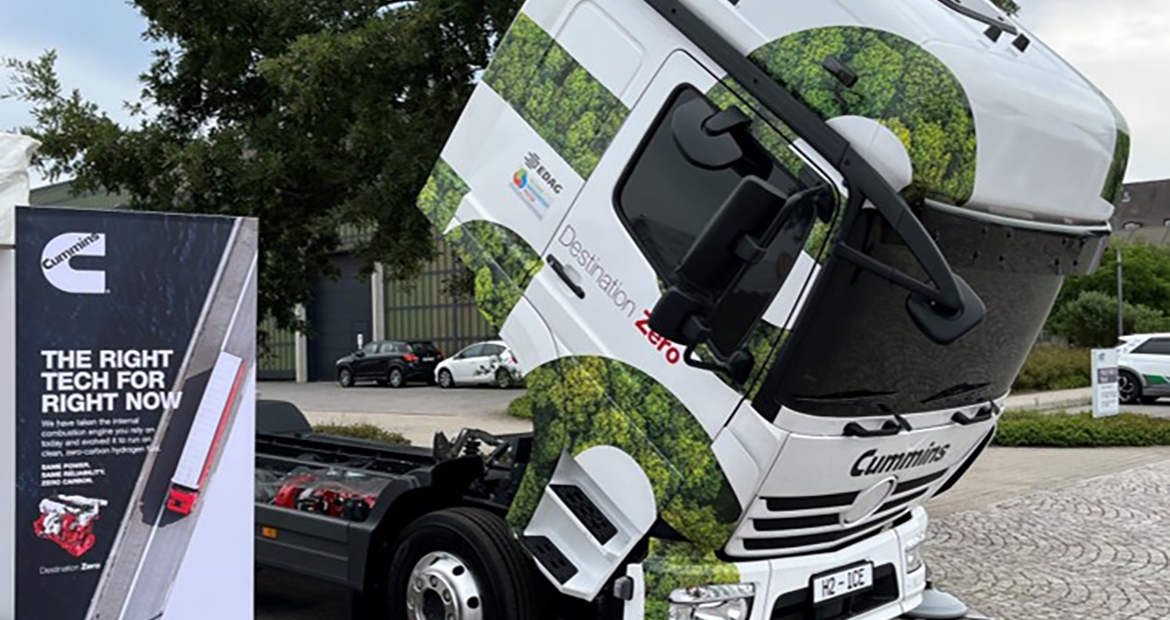Hydrogen Internal Combustion Engines: Trending Topics from Hydrogen Engine Live
By Cummins Europe, Global Power Technology Leader

The profile of hydrogen internal combustion engines (H2-ICE) has been rising for some time now, but the potential of the technology is only now being fully appreciated.
While the future of hydrogen combustion is an exciting prospect, widespread understanding and adoption of the technology is still in its infancy. To address this and discuss the progression of H2-ICE with market leading OEMs and policymakers, Cummins recently attended Hydrogen Engine Live, hosted by the Hydrogen Engine Alliance in Germany.
Tony Satterthwaite, Senior Vice President spoke at the event and participated in a panel discussion alongside senior leaders from Bosch, Mahle and Karlsruhe Institute of Technology as well as policy makers from Germany’s government. You can see an interview with Tony Satterthwaite at the event here: Impressionen von der Wasserstoffmotor LIVE der Allianz Wasserstoffmotor · 30.06.2023 · KIT Karlsruhe - YouTube
TOP 3 TAKEAWAYS
1. Government policy
The fundamental issue impacting the future of hydrogen internal combustion technology is its inclusion in policy as a zero emissions vehicle (ZEV) power solution. The argument for H2-ICE's recognition as a ZEV power solution is compelling and global regulators are recognising the role the technology can play in decarbonising the commercial vehicle industry.
Whilst not delivering absolute zero emissions, there are no carbon or greenhouse gas emissions from hydrogen - it's a zero-carbon fuel. When operating on green hydrogen (produced from renewable sources), H2-ICE provides a zero-carbon well to wheels solution with near zero NOx and particulate matter (PM).
H2-ICE could positively impact climate change yet this decade. NOx and PM emissions are well below current Euro VI levels and will comfortably meet proposed Euro 7 regulations, in fact higher volumes of particulate matter are produced by tyres and brakes than at the tailpipe.
Effective collaboration between governments and industry is crucial. Only by working together, can we unlock the full potential of hydrogen as a clean and sustainable energy solution, benefiting both the industry and society. The EPA and European Commission formalising H2-ICE as a zero-emissions power solution will be an important milestone in realising hydrogen's potential, and it is hoped that other regulators will follow suit.
2. Infrastructure
Once policies on H2-ICE as ZEV are made clear, investment in infrastructure must be planned and implemented with vigour. The industry is under no illusion that for hydrogen to reach its full potential, adequate infrastructure needs to be created to produce green hydrogen in quantities that make it accessible and affordable.
This challenge is universal and refuelling stations, pipelines, and storage facilities take time and require significant investment to develop. The sooner potential investors have clarity on policy, the sooner improvements to infrastructure can be made.
Encouragingly, many markets have been quick to support and scale up a robust hydrogen economy. The U.S. is making progress: the Inflation Reduction Act and Infrastructure Bill are already having a very real and positive impact on Cummins by incentivising US investment in clean energy.
3. Adoption
Many OEMs and end users might find themselves wondering if now is the time to invest in H2-ICE if they feel that hydrogen fuel cell technology is imminent as another ZEV solution. Put simply, it is not an either-or debate.
Hydrogen internal combustion engines will complement the development of fuel cells by accelerating infrastructure roll out as well as customer acceptance of hydrogen as a fuel. With a lower upfront cost, H2-ICE could facilitate carbon reductions sooner with a product, supply chain and parts network familiar to OEMs and operators globally.
H2-ICE looks like an engine, sounds like an engine, fits where an engine normally fits and mechanics know how to work on it. As such, they can be deployed quickly without huge changes to existing vehicle designs or major disruptions to our customer's operations.
Resumen
H2-ICE is a viable and familiar technology that could support decarbonisation of a myriad of industries, not least commercial transportation. The launch of Cummins' 6.7 and 15-litre hydrogen internal combustion engines, part of our fuel agnostic engine series, exemplifies how H2-ICE can offer a tangible solution to reduce emissions from medium and heavy-duty applications whilst maintaining the critical performance needed for intense and high-endurance work.
Clearly, there is work to be done. Policy, infrastructure and customer adoption are symbiotic and one won't happen without the others. At Cummins, we are already seeing an encouraging appetite for H2-ICE technology, even in the absence of clear policy or infrastructure roll out. Several agreements have been already signed with key customers with more to be announced in the future.
Author Profiles
Cummins Europe, Global Power Technology Leader
Cummins Inc. opened its first site in Europe in 1956. Today it has 12 manufacturing sites and more than 10,800 employees in the region. Cummins works hard to provide advanced technologies supported by a long-established service network across Europe. Cummins is committed to investing in Europe through Research and Technology, ensuring Cummins' technical experts are developing innovations of the future.